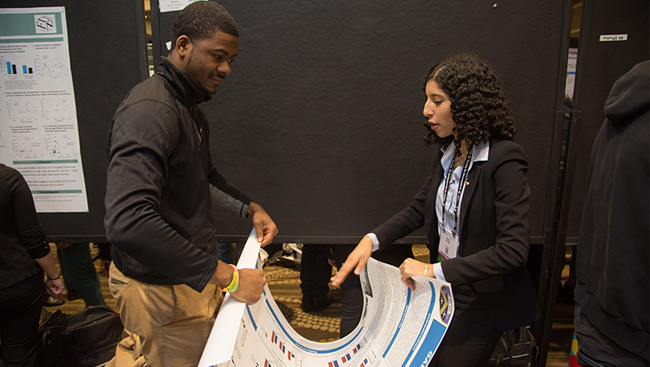
As neuroscientists, there’s a lot to gain from taking a step outside our comfort zones.
Early on in my role as a Science and Technology Policy Fellow with the American Association for the Advancement of Science (AAAS), I learned sometimes expertise is relative. Scientists from many disciplines can learn from one another.
I am hosted at the National Institute of Justice (NIJ), the Department of Justice's research and evaluation agency, which funds research of interest to the criminal justice system.
Along with the other AAAS Fellows, I am one of only a handful of trained neuroscientists at NIJ. We are called upon to provide insight from neuroscience and cognitive science on topics of interest to the criminal justice system, such as:
- Eyewitness identification, considering factors of memory, perception, and attention.
- Effects of trauma and chronic stress on officers, victims, and offenders.
- Addiction, especially in context of the opioid epidemic.
- Development and aging, as applied to juvenile offenders, aging prisoners, and victims.
When I started my fellowship position, I was thrust into a world of topics and culture I knew little about. I eventually overcame the initial culture shock and realized although my colleagues hailed from a wide variety of scientific fields, such as chemistry, biology, engineering, criminology, and sociology, we’re still fellow scientists.
I began appreciating how much I could learn by talking with scientists outside my academic niche. And I don’t just mean stepping outside the small community of colleagues and collaborators working in the same topic areas and using the same methods, I mean taking a big step away from other neuroscientists and interacting with scientists in other fields.
There's much more that unites us as scientists than divides us by discipline.
Although we neuroscientists might complain about more industry money being available for chemistry, or how easy astrophysicists or computer scientists seem to have it, the struggles of getting research funding, going through peer review, and surviving graduate school are fairly universal across scientific disciplines.
Working with scientists in other fields forces you to clearly explain your research.
Effectively communicating your background and methods to peers who are highly educated but not versed in the intricacies of your field is a different set of communication muscles than you’d use in a classroom or explaining your science to the lay public.
These "advanced science translation" skills can be highly useful as you forge interdisciplinary collaborations or communicate the benefits of those collaborations to review panels.
Solid interdisciplinary science provides tools and evidence that better inform the policy makers and agencies who uphold justice.
Interdisciplinary science is especially important to society. I’ve seen this first-hand researching the criminal justice system. Crime and justice are societal problems that are hard to address and go beyond simply finding a drug or vaccine for a medical disease. Because of that, it may seem like other scientific disciplines make more of a direct impact than neuroscience.
In forensics, for example, research in chemistry, molecular biology, and other fields is needed to confirm the scientific reliability and validity of latent fingerprint or firearm residue analysis. However, this work is in vain if we don't also study how cognitive and perceptual biases can influence laboratory technician behavior.
Furthermore, as neuroscientists, we can take what we understand about memory and apply it to eyewitness identification or take what we understand about the developing brain and apply it to how we consider juvenile and young adult offenders.
We then have the opportunity to show those who have funded our work — lawmakers and the public — the full value of their investment.
So how do you build these interdisciplinary connections? I'll offer a few concrete steps:
- Get out of your comfort zone at your institution. Go to a seminar outside your department or invite other departments to yours. Get involved with institution-wide organizations like your graduate student senate, postdoctoral association, or faculty council.
- Follow other scientists on social media. Twitter can be great for connecting with scientists who might be doing different, but related work. Some accounts, like @realscientists, rotate through weekly scientists from a wide variety of fields.
- Volunteer at STEM outreach events, whether they are small local events in your community, or large ones like the USA Science and Engineering Festival. These events are an excellent opportunity to practice discussing your science with the public and a great way to find scientists in different disciplines who are similarly committed to sharing and talking about their work.
- Join interdisciplinary science organizations like AAAS, Graduate Women in Science, Society for Advancement of Chicanos/Hispanics and Native Americans in Science (SACNAS), or Out in STEM (oSTEM) and attend their annual meetings, organize an interdisciplinary research symposium, or engage with them in other ways.








